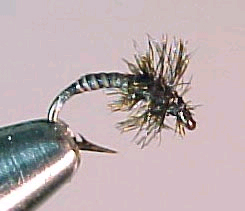
On The Fly
January 2011
"Fly tying is a school from which we never graduate"
TYING NEWS
The Southern Oregon Fly Tyers invite you to attend their meetings the second Tuesday
of each month. The next meeting is January 19, 2011. The meetings start at 6:00 PM, at the Madrone Hill
Mobile Home Park community building near Gold Hill. Bring a friend, come early so you don't miss anything,
and stay late. Tyers need not be experienced, and those with all levels of skill are welcome. Each meeting
a member is encouraged to demonstrate a new or different skill, from simple to difficult. For more
information, call Dan Kellogg at 773-4724.
There will be two presenters at the January meeting, Joe Holzen and Morris Fruitman. Joe
is going to share his special minnow with us. Morris will bring all the materials and construct a shadow
box to mount display flies in. He'll go through all the steps to put one of these together. While you won't
have time to build one yourself, you'll receive a handout with the list of materials, so you can build one
later.
DIRECTIONS: Take Gold Hill Exit #40, off of I-5 and go west, toward Jacksonville, 1.3
miles, until you reach the brick entrance way to the Madrone Hill Mobile Home Park on the right. You’ll
pass a golf course parking lot on Your left shortly after leaving the freeway. After you turn right into the
mobile home park, proceed to the community building which is located about 100 yards ahead on the left. The
address is 8401 Old Stage Rd. Please park your vehicle on the bare dirt in the parking lot to avoid the
wooden septic covers in the grass.
PATTERN OF THE MONTH - Peacock Herl Midge

Hook: Daiichi 1140, Midge/Emerger, size 18 - 22
Thread: 8-0 black.
Abdomen: Stripped Peacock herl.
Thorax: Peacock herl.
Head: Thread
Tying Instructions
Step 1 Mash the barb and mount the hook in the vise.
Step 2: Start the thread one eye width behind the eye and lay down an even thread base to a position halfway
down the bend.
Step 3: Select one stripped peacock herl, clip off one inch of the fragile tip section, and tie in at the
bend half-way point. Wrap the thread to a position 1/3 shank length from the eye. Wind the stripped herl
forward in touching turns to the thread hanging position. Tie off and trim the excess.
Step 4: Select one regular Peacock herl and tie in at the base of the abdomen, grab the herl strand, take
one wrap over the shank, and wrap it around the thread three times. Now grab the herl and the thread
between your fingers and wind the herl rope forward 4 turns forming the thorax. Tie off and trim the excess.
Step 5: Form a small neat head, whip finish and cement.
This month's pattern, the Peacock Midge, is simple but effective. There is no question
about the effectiveness of Peacock herl on any fly. One hook, some thread, and one material definitely
qualifies it as simple to tie. The only challenges are the small size and the body quill prep. I have even
included the methods below. Midges are the most abundant trout food source in the colder winter months on
the Rogue. On February 26th Rich Fiebelkorn will be hosting a Holy Water midge fishing outing. He will even
show you how to fish the critters. Sounds to me like all you have to do is spend a little time at the vise,
dress warm, and show up.
Preparing the stripped herl.
Before your Peacock herl is ready to be used as a quill, you must remove the tiny fibers
which are on the black edge. The simplest and most direct approach is to remove them by hand. These are
best for small quantities of quills. One method is to remove the flue by gently stripping it with your
thumbnail, stroking it gently against the grain from tip to butt. It may take several light strokes to
remove all the fibers. The second method is somewhat faster and requires the use of a course ink eraser.
Lay the herl on the tabletop, hold down by the tip and rub the eraser tip to butt against the grain. Turn
the herl over and repeat until clean. If larger numbers are needed you may want to try the chemical
bleaching method. The burning solution is a 50/50 mix of bleach and water and involves immerse an entire
eye section for 20 to 30 seconds. Remove, rinse under clear water, and check if any fibers remain. Repeat
if necessary for another 10 seconds and rinse again.
TYING TIPS
No matter what method you use to strip the quills, the prepared material should be soaked
in water before using. Soaking renders them soft, pliable, and much easier to wrap around the shank without
breaking or splitting. If you plan to tie several dozen flies at a time, unused quill can be stored in a
covered jar of water and kept for several months. So tie some up, give them a test flight, and let me know
how you do.
Tie One On,
Dan Kellogg (you can contact me at FLYGUY@EZNORTHWEST.COM)